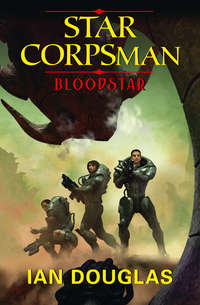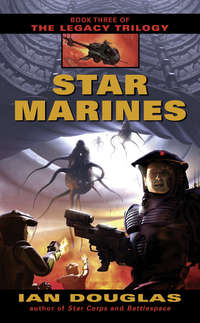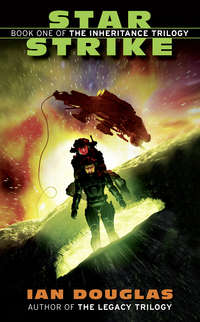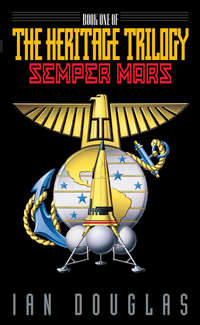
Полная версия
Singularity

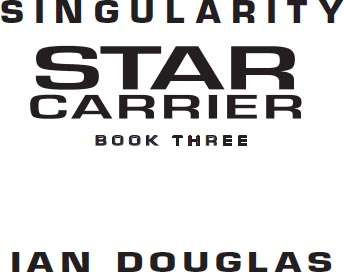


Copyright
HarperVoyager
An imprint of HarperCollinsPublishers Ltd.
1 London Bridge Street
London SE1 9GF
www.harpercollins.co.uk
First published in Great Britain by HarperVoyager 2012
Copyright © William H. Keith, Jr 2012
William H. Keith, Jr asserts the moral right to be identified as the author of this work
Cover art by Gregory Bridges
A catalogue record for this book is available from the British Library
This novel is entirely a work of fiction. The names, characters and incidents portrayed in it are the work of the author’s imagination. Any resemblance to actual persons, living or dead, events or localities is entirely coincidental.
All rights reserved under International and Pan-American Copyright Conventions. By payment of the required fees, you have been granted the non-exclusive, non-transferable right to access and read the text of this ebook on-screen. No part of this text may be reproduced, transmitted, downloaded, decompiled, reverse engineered, or stored in or introduced into any information storage and retrieval system, in any form or by any means, whether electronic or mechanical, now known or hereinafter invented, without the express written permission of HarperCollins ebooks
HarperCollinsPublishers has made every reasonable effort to ensure that any picture content and written content in this ebook has been included or removed in accordance with the contractual and technological constraints in operation at the time of publication
Source ISBN: 9780007485956
Ebook Edition © November 2012 ISBN: 9780007485963
Version: 2017-09-12
For Deb, whose science is about as hard as it comes
INTO THE JAWS OF A SAVAGE GOD
Gray was sliding down a gravity well, as though he were being funneled straight toward the wildly rotating cylinder ahead.
Somehow, he realized, the Sh’daar had compressed a medium-sized star into a hollow cylinder a kilometer across and twenty long. Something didn’t add up. Beings that could create this thing weren’t merely good magicians. They were gods, or the closest thing to gods mere humans could imagine.
Gray’s fighter, falling free, was accelerating, moving faster and faster as the maw of the cylinder yawned ahead, the opening empty and utterly lightless.
Fifty more seconds, at this rate, and he would be drawn inside.
If the Sh’daar possessed such power, they didn’t need to rely on the Turusch or their other subject species.
Why fight this protracted war for almost forty years, when such technology could wipe Humankind out of existence with scarcely a thought?
Table of Contents
Title Page
Copyright
Dedication
Into the Jaws of a Savage God
Prologue
Chapter One
Chapter Two
Chapter Three
Chapter Four
Chapter Five
Chapter Six
Chapter Seven
Chapter Eight
Chapter Nine
Chapter Ten
Chapter Eleven
Chapter Twelve
Chapter Thirteen
Chapter Fourteen
Chapter Fifteen
Chapter Sixteen
Chapter Seventeen
Chapter Eighteen
Chapter Nineteen
Chapter Twenty
Chapter Twenty-One
Chapter Twenty-Two
Chapter Twenty-Three
Chapter Twenty-Four
Chapter Twenty-Five
Chapter Twenty-Six
Epilogue
Keep Reading
About the Author
By Ian Douglas
About the Publisher
Prologue
5 April 2405
Ad Astra Confederation Government Complex
Geneva, European Union
1450 hours, local time
It’s not possible to torture a piece of software. Not even an intelligent one.
Not that artificial intelligences possess anything like the civil rights of humans. With no rights to violate, the Internal Affairs interrogators could take the AI apart almost literally line by coded line, searching for hidden files or withheld memories.
The software avatar’s prototype, as its human object was known in the electronic intelligence business, had recorded a sizable amount of his own character, thoughts, and motivation within his AI counterparts. It was always possible that thoughts, memories—even entire histories—had slipped through from the fuzzy logic and holographic analog perceptions of the organic brain to a far simpler silicon-based digital format. This particular prototype was Admiral Alexander Koenig, and he worked closely with his AI personal assistant.
He had, in fact, developed what amounted to an emotional relationship with it, deliberately programming it with the personal characteristics—voice, thought patterns, judgment, the simulacra appearance, and so on—of his lover, Karyn Mendelson, killed during the battle to save Earth’s solar system just over six months earlier.
The primary software resided inside Koenig’s head, within the nanochelated implants in the twisting folds and furrows of the sulci of his brain. It served as his PA, or personal assistant, a kind of electronic secretary that could handle routine calls and virtual meetings, could so perfectly mimic Koenig’s appearance, voice, and mannerisms that callers could not tell whether they were speaking to the human or to the human-mimicking software. However, more than a month before, shortly after the Battle of Alphekka, Rear Admiral Koenig had copied his PA software, uploading it into one of the HAMP-20 Sleipnir-class mail packets carried as auxiliaries on board most of the ships of the fleet. Almost three times faster than the best possible speed for a capital ship under Alcubierre FTL Drive, they were used to carry high-velocity express communications across interstellar distances.
It had been this copied software that had piloted the most recent mail packet from Alphekka back to Earth.
And multiple copies of this copy were running inside the computers of the Naval Department of Internal Affairs, completely isolated from the outside world, electronic iterations that could be taken apart, tested to destruction, electronically shredded and pulled through a metaphorical sieve, in search of possible traces of Koenig’s thoughts.
Karyn Mendelson possessed within her coded matrix a very great deal of both the original Mendelson and of Koenig himself. And it was the Koenig analog in which the Internal Affairs officers were most interested.
“Anything?” one shadowy figure asked the other. They were deep in the nuke-shielded lower levels beneath the ConGov pyramid, perhaps three kilometers down and well out under the placid-mirrored waters of Lake Geneva itself.
“No,” the other said. He gestured vaguely at a wallscreen, which showed a graphic representing progress so far. There’d been very little. “This is going to take a while.”
“What are you trying?”
“Incoming call iterations. It’s cycling through at almost a million per second now.”
The first IA programmer gave a low whistle. “He’s got the top-of-the-line model, huh?”
“He’s a freakin’ rear admiral, fer Chrissakes. What did you expect?”
Within the computer in the console in front of them, a subroutine was emulating real life for the admiral—but at a vastly accelerated rate. A copy of his PA software was fielding incoming vid calls as Koenig, very quickly indeed. Eventually, the orderly presentation of the program would begin to break down, and other watchdog routines would snatch at what amounted to electronic shrapnel, saving it for later analyses.
They’d already destroyed a dozen copies of the PA software … but there were plenty more, and more could be created easily enough if these ran out.
And abruptly, the emulation stopped.
“What the hell happened?”
“Dunno. And what’s that?”
On the large screen, a woman in a black Confederation naval uniform looked down at them. “Who are you?” she demanded. “What are you doing to me?”
One of the interrogators gave her a cool appraisal. “You’re Mendelson?” he asked.
The screen image morphed into Koenig, also in naval uniform, and looking angry. “This is the personal assistant of Rear Admiral Alexander Koenig,” it said. “And attempting to hack private PA software is illegal.”
“Department of Internal Affairs,” the interrogator replied. “We have authorization.”
“To do what? And by whose authority?”
The interrogator showed the AI behind the screen image his security code level. Possibly they could get what they needed by asking directly, if they could enlist the AI’s cooperation.
“We are trying to get a lead on where Admiral Koenig is taking CBG-18,” he said. “It is vital that we get in touch with him, and we’d hoped you might be able to help.”
“I was … he was at Alphekka when I was downloaded into a Sleipnir-class packet,” Koenig’s face said. “I have no idea what has happened with the fleet since I left it for Earth.”
A copy of a copy, its memories had been copied as well. It would think that it was the original electronic duplicate placed in the mail packet.
“You brought with you a list of over two hundred possible targets,” the interrogator said. “We think he must be headed for one of those. Can you tell us which one that might be?”
“No,” the electronic image on the screen said. “If Admiral Koenig had wanted you to know, I feel sure he would have told you in his final report.”
And as suddenly as Koenig’s image had appeared, it was gone, dissolving into a shrill hiss of white noise.
“Damn.”
“What happened?”
“The software … killed itself,” the interrogator said. “Electronic suicide.”
“It can’t kill itself if it’s not alive to begin with.”
But the interrogator wasn’t certain of that. Other iterations of Koenig’s software had switched themselves off when they’d discovered that he was tampering with them.
He loaded another copy.
“We’ll try again,” he said. “But I have a feeling it’s going to be a long night. …”
Koenig’s electronic persona seemed determined not to cooperate, and he could not figure out how to get past the program’s guardian aspect.
The interrogator was very good at what he did.
There had to be a way to break the thing. …
Chapter One
10 April 2405
In Alcubierre Space
Approaching HD 157950
98 light years from Earth
0840 hours, TFT
The star carrier America fell through darkness absolute.
Intense, artificially generated gravitational fields warped space tightly around the America, and no light could enter from the universe outside. While material objects like a spacecraft could not travel faster than light, there was no such prohibition about space. Indeed, in the earliest moments of the big bang, over 13 billion years before, newly born space had expanded with that initial burst of energy from two colliding branes considerably in excess of c.
And a ship embedded within that swiftly moving space could be carried along inside the gravitationally closed bubble at a pseudovelocity of nearly two light years per day.
America and her battlegroup had been traveling through the darkness within their separate bubbles for sixty-three days, now. And they were very nearly at the end of the first leg of their voyage.
Rear Admiral Alexander Koenig, the battlegroup’s CO, was seated in America’s command lounge. The room, broad and circular, projected the surrounding vista across the gently curved overhead when the ship was in normal space, showing the unmoving panorama of stars outside. Within the confines of metaspace, however, the interior of the fast-moving bubble of enclosed space-time, the lightless Void was at arm’s length. Currently, it was displaying the blue, cloud-scattered skies of Earth.
Two men appeared in the lounge entryway. “You wanted to see us, Admiral?”
Captain Randolph Buchanan was America’s commanding officer, tall, long-faced, with perpetual worry lines. Captain Barry Wizewski was the CO of the star carrier’s space-fighter wing commander, her CAG—an ancient acronym derived from “Commander, Air Group.”
“I did. C’mon in.”
“Staying off the record, sir?” Wizewski said, smiling.
“Yes, actually. I don’t expect to salvage my career after this, but I’ll be damned if I’ll give them the rope to hang me … or anything on the record to drag you into this.”
Anything discussed on either America’s main bridge or her flag bridge was recorded, as were conversations in the Admiral’s Office and all other working compartments on board ship. Virtual meetings held in-head were recorded as well by the ship AIs responsible for moderating all electronic communications.
“You’re doing the right thing, Admiral,” Buchanan told him, taking one of the low, round seats opposite Koenig.
“Thanks, Randy. But we both know the Senate’s never going to stand for this kind of insubordination. They can’t, not without looking like they’re not in control.”
“The Confederation Senate, no,” Buchanan replied. “Things may be different in Columbus, D.C.”
“Maybe. But it’s Geneva that’s calling the shots, and Columbus will have to go along.”
Koenig had never been entirely comfortable with his position as commanding officer of a Confederation Star Navy battlegroup. The star carrier America and her crew were USNA—the United States of North America—but they’d been reassigned along with most of the other ships of CBG-18 to the service of the Terran Confederation.
The problem, Koenig thought wryly, was that while the majority of Confederation naval officers—including the Joint Chiefs of Staff—were USNA citizens, the majority of the Confederation’s politicians were not. It was the Pan-Europeans, the Empire of Brazil, the South American EAS, the North India Federation, and others who were determining Confed policy in Geneva. Those nation-states that tended to support the USNA’s initiatives in the war with the Sh’daar were badly outnumbered—Russia, the off-world colonies, and Japan.
There were times when he was forced to walk an extremely narrow path between his oath to the Confederation … and his allegiance to the USNA.
“We’re … what?” he said. “Ten hours out from Emergence?”
“Yes, sir,” Buchanan replied.
“We don’t know if Giraurd followed us.”
“We don’t need him,” Wizewski said. “The USNA reinforcements are solidly with us. I think the Chinese are too.”
“I’m not worried about that,” Koenig said. “If the Pan-Europeans followed us from Alphekka, they might try to force the issue when we emerge.”
Buchanan nodded. “Giraurd didn’t seem all that happy when you told him off.”
“No. And his orders are to bring us back. But … I’m not ready to do that yet. We haven’t finished what we’ve started.”
“Do you expect a fight, Admiral?” Wizewski asked.
“It’s at least a possibility. And we need to be ready, just in case. No matter what Giraurd decides to do.”
“If he was smart,” Buchanan said, “he turned around and headed back to Earth to report. Tell them that we weren’t playing nice.”
“His orders might not allow that,” Koenig replied. “In fact, he may be under orders to take us under fire if we refuse to go back. He was certainly threatening as much when we started accelerating out-system from Alphekka.”
“Threats,” Wizewski said. “Blusters and bluff.”
“Maybe. But, as I said, I want to be prepared for anything. CAG, I’m going to have you put everything we have into space as soon as we emerge. We’ll pass the word to the other carriers to do the same as soon as we’ve re-established contact. Randy? I want you to make sure America stays well clear of the Pan-Europeans if and when they emerge. Don’t let them sidle up close for a conference. Don’t allow them to send over small craft to discuss things. And be ready to put out a warning shot if they do try to force their way inside our primary defensive zone.”
“Yes, sir.”
Koenig looked at Wizewski. “CAG? How are the reorganized squadrons shaping up?”
“Not as good as I’d like, Admiral. The new recruits have been training hard on the sims, but that won’t haul much mass when they hit the real thing.”
Koenig nodded. America’s squadrons had taken fearsome losses at Alphekka; one had been reduced to just three fighters.
“I hope to God they don’t get their baptism of fire against humans,” he said. “But if it’s a matter of guaranteeing the safety of this carrier …”
“They’ll do what they have to, Admiral. They all will. I don’t think any of them care all that much for the Confederation, when it comes to that. Their loyalty is to the USNA, to America, to you and me, to their buddies. … Hell, I think Geneva comes in somewhere way down on the list. Fiftieth or sixtieth, maybe.”
“I want you to impress on the squadron leaders, CAG, that their squadrons will not open fire on human ships unless they receive a direct and confirmed order from you. Understand?”
“Yes, sir.”
“If there’s a diplomatic way to resolve this, I’m going to take it. The last thing I want is to add a civil war to the war we already have.”
“I understand, Admiral.”
“I know you do. See to it that they understand as well.”
There was little more that could be said.
Koenig dismissed the two of them, and returned to his brooding thoughts.
Star Chamber
Ad Astra Confederation Government Complex
Geneva, European Union
0950 hours, TFT
President Regis DuPont hated the place. It felt so exposed … so empty.
Well … it was filled with stars, of course, but somehow that made it even worse.
The star chamber was a planetarium and more, much more—an immense sphere a hundred meters across, the inner surface designed to project imagery relayed from the big astrogational complex at Bern. Near stars were shown scattered across the interior space, scattered through three dimensions; more distant stars and the glowing, ragged lace-work of the Milky Way were projected against the curving inner surfaces.
Followed closely by a small knot of people, his personal security detachment and presidential aides, DuPont walked out onto the narrow catwalk leading to the viewing platform suspended at the sphere’s center. The others were waiting for him there already, a dozen Confederation senators in civilian dress, their shoulders and sleeves heavy with the gold and silver brocade, aiguillettes, medals, and intertwining decorations that declared their importance.
There were no military officers present, though, and DuPont wondered why.
For that matter, he didn’t see any senators with military experience—or any representing outworld colonies, like Andrews or Kristofferson.
Sometimes it was possible to judge which way the political winds were blowing by noting who was present … or absent.
“Mr. President,” Senator Eunice Noyer said, nodding. “Thank you for coming.”
“Why here?” he asked. “Why not at ConGov?”
“Because,” Noyer said, “the America Battlegroup could pose a problem. We’re trying to determine just where Koenig is going now.”
“Surely that’s something the Confederation Military Directorate could advise you on,” DuPont said. “The Joint Chiefs, I gather, have been following Koenig’s campaign with great interest.”
Noyer made a face. “They’re no help. Not to us.”
“They may well be in collusion with one another,” Senator Sheehan added. “Carruthers wasn’t supposed to send Koenig reinforcements. He was supposed to order Koenig to return to Earth.”
“The military,” Senator Galkin pointed out, “is no longer trustworthy. Carruthers and his cronies need to be reined in, reined in hard. Too much is riding on this. The safety of Earth, of all of Humankind, is at stake.”
“So?” DuPont said with a Gallic shrug. “Where is the battlegroup now?”
“We don’t know for sure.” Noyer told him. “CBG-18 has left Alphekka … but it’s not returning to Earth. According to Giraurd’s report, the CBG is heading for a nondescript star called HD 157950.” The red line drew itself from Alphekka across the sky to the right, touching another star, a dim one. “Ninety-eight light years from Earth. One hundred fourteen light years from Alphekka.”
“That’s not on the Directory,” DuPont said. “What’s there?”
“Nothing, so far as we know. It may be that he intends to take on reaction mass there. Likely it is a waypoint, with the final destination somewhere … farther out.”
Senator Lloyd gestured, and a red beam of light drew itself out from the observation platform, connecting with one of the near stars—a golden-orange sun gleaming at the base of the constellation of Boötis. “On January seventh,” he said in a lecture-hall monotone, “the battlegroup leaves Fleet Rendezvous Percival—Pluto orbit—and does so apparently after learning from an incoming mail packet that the Sh’daar had taken Osiris, at Seventy Ophiuchi.” A fainter star well off to the group’s left flashed bright white. “The battlegroup proceeds to Arcturus, thirty-six light years from Earth, where it engages the ships of several of the Sh’daar client races and rescues a number of human prisoners of war, at Arcturus Station.”
“The plan,” DuPont said, “was to raid deep into Sh’daar space, perhaps forcing the Sh’daar to pull back, at least to delay them.”
“Indeed,” Senator Suvarov said. “There was talk of raiding Eta Boötis after Arcturus. The two are only a few light years apart.”
“Instead,” Noyer said, “Koenig leads his fleet all the way across to here.” Another star, somewhat above and to the left of Arcturus and twice as far away, lit up as the red line connected them. “Alphekka. Seventy-two light years away. If the report is to be believed, he engaged a much larger Sh’daar client force and destroyed a moon-sized construction facility. At this point, he has a large percentage of our defensive fleet engaged seventy-two light years away … while the Sh’daar remain at Osiris, just sixteen light years from Sol. Sixteen light years! The enemy could be here at any moment!”
“Well … it’s been … what? Six weeks since the Battle of Alphekka?” DuPont said. “And the Sh’daar have not materialized in Earth orbit yet. Perhaps Koenig’s plan to draw them off is working.”





